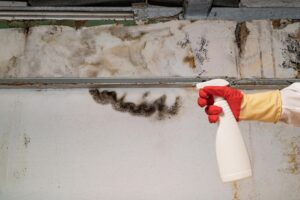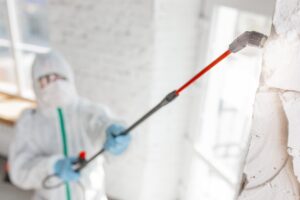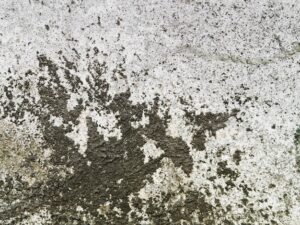
Wondering how much it costs to remove black mold from your home? Discover everything you need to know about black mold removal, including black mold abatement cost, cost of black mold in shower, and black mold remediation prices.
Black Mold Cost |
| Average Cost | $2,500 |
| Highest Cost | $15,000+ |
| Lowest Cost | $350 |
Introduction to Black Mold
In Fort Myers, FL, black mold is a type of fungus that thrives in damp, humid environments. It can cause significant damage to homes and pose serious health risks. It’s essential to understand how it forms, its dangers, and how to handle its removal.
What is Black Mold?
Black mold (Stachybotrys chartarum) is a toxic mold species, recognized for its greenish-black appearance. It’s often found in areas with excessive moisture, such as basements, bathrooms, or places affected by water damage. This mold produces mycotoxins that can be harmful when inhaled or touched.
How Black Mold Forms
Black mold forms when there is a consistent presence of moisture. It thrives on organic materials like wood, paper, and drywall, typically in spaces with poor ventilation or where water damage has occurred. Leaky pipes, flooding, or high humidity can all contribute to mold growth.
Health Issues Due to Black Mold
In Fort Myers, FL, black mold exposure can lead to various health issues, particularly in sensitive individuals. Respiratory problems like coughing, wheezing, and nasal congestion are common, as are skin rashes and allergic reactions. Long-term exposure may result in more severe symptoms, including headaches, chronic fatigue, and even neurological effects in some cases. Those with asthma, allergies, or weakened immune systems are at higher risk.
Black Mold Removal cost VS Other types of Molds Removal Cost
| Mold Type | Cost Range | Details |
| Black Mold Removal Cost | $2,000 – $10,000 | Toxic mold with significant health risks, often requires extensive removal. |
| Alternaria mold Removal Cost | $1,500 – $6,000 | Common indoor mold is found on fabrics, walls, and carpets. |
| Cladosporium mold Removal Cost | $1,000 – $5,000 | Non-toxic but can cause allergic reactions; thrives on damp wood or fabrics. |
| Penicillium mold Removal Cost | $1,000 – $4,000 | Known for spreading quickly; often found in water-damaged buildings. |
| Aspergillus mold Removal Cost | $500 – $4,000 | Common household mold; can cause irritation and allergic responses. |
| Fusarium mold Removal Cost | $1,500 – $6,500 | Found on water-damaged materials, poses health risks to respiratory systems. |
| Toxigenic Mold Removal Cost | $3,000 – $10,000+ | Produces mycotoxins; removal requires specialized treatments. |
| Outdoor Mold Removal Cost | $500 – $3,000 | Found on external structures; removal focuses on environmental control. |
| Common Indoor Mold Removal Cost | $1,000 – $4,500 | Includes various non-toxic molds causing mild allergic reactions. |
Factors That Affect Mold Removal Costs

Several factors can influence the overall cost of black mold removal:
Size of the Area: The larger the area affected by mold, the higher the cost. Mold removal professionals often charge per square foot, with rates ranging from $15 to $30 per square foot.
Extent of Damage: If the mold has damaged materials like drywall, flooring, or insulation, the cost will rise.
Prices of black mold on drywall: often require a higher removal cost due to the material replacement involved.
Mold Type: Black mold and other toxic molds require special equipment and techniques for safe removal, which can increase the cost. Other types of mold, such as Aspergillus, are easier to deal with and may cost less to remove.
Steps Involved in Black Mold Removal
Inspection and Assessment: A thorough inspection is essential for determining the cost of black mold in the shower or any other affected areas. Professionals use moisture meters and thermal cameras to detect mold behind walls or in hidden spaces.
Cleanup and Remediation: Cleaning black mold involves cleaning the affected area and removing any contaminated materials like drywall, carpets, or insulation. A black mold remediation price can vary depending on the severity of the infestation and the materials involved.
Post-Removal Treatment: After the remediation, a post-treatment is necessary to prevent mold from returning. This can include sealing the affected area with mold-resistant coatings or applying a moisture control solution to maintain proper ventilation and humidity levels in the future. Regular monitoring may also be recommended to ensure the area remains mold-free.
Prevention: How to Avoid Future Mold Growth
Moisture Control and Ventilation: One of the most effective ways to prevent mold growth is by controlling moisture. Mold thrives in damp environments, so keeping humidity levels low (ideally between 30-50%) can drastically reduce the likelihood of mold developing. Ensure proper ventilation in areas like kitchens, bathrooms, and basements by using exhaust fans or opening windows to increase airflow and dry out damp areas quickly.
Mold-Resistant Products and Materials: Incorporating mold-resistant materials, such as mold-resistant drywall, paints, and sealants, can help prevent mold growth in the future. These products are designed to resist moisture absorption and slow down the growth of mold and mildew. Using such materials in high-humidity areas can significantly reduce mold risks and improve the longevity of your home’s interior surfaces.
Conclusion:

In Fort Myers, FL, black mold abatement costs can range from $1,500 to $10,000 depending on the severity of the infestation and the area affected. Whether you need removal in your shower or on drywall, investing in professional black mold remediation is essential for both health and property preservation. The cost to remove black mold may seem high, but addressing mold problems early can save you significant money and health risks in the long run. Toxic mold treatment is a crucial step to safeguard your home and health. Prevention is key—keep humidity levels low and address leaks promptly to avoid the need for costly mold removal in the future.
FAQs
Signs of black mold include a musty smell, discoloration on walls or ceilings, and allergic reactions like coughing or sneezing. A professional inspection can confirm the presence of mold.
The removal process typically takes a few days to a week, depending on the size of the affected area and the severity of the mold growth.
Excess moisture due to leaks, high humidity, or poor ventilation creates ideal conditions for black mold to grow.
Yes, if the underlying moisture issues are not addressed, black mold can return. Regular monitoring and maintenance are crucial.
Yes, black mold can cause serious health issues, including respiratory problems, allergies, and more severe reactions in those with weakened immune systems.
Lorem ipsum dolor sit amet, consectetur adipiscing elit. Ut elit tellus, luctus nec ullamcorper mattis, pulvinar dapibus leo.
